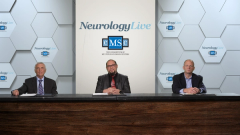
Cognition and Brain Health Biomarkers in Multiple Sclerosis
Drs Randall Schapiro and Jeffrey Wilken explore the idea of cognition and brain health biomarkers in multiple sclerosis and provide imaging and diagnostic recommendations.
Episodes in this series

Ahmed Obeidat, MD, PhD: Now, we’ll switch gears a little bit here where we will be talking about biomarkers and this is always a hot topic in MS [multiple sclerosis] now in everything. Biomarkers of each of the following. When it comes to cognition, what are the biomarkers available for us? And I would say both imaging-wise and maybe testing. Thus, I’ll start with you.
Randall Schapiro, MD, FAAN: I’ll be a little controversial and say, there are no biomarkers for cognition. Now, I recognize that the MRI has become a really important diagnostic tool in MS. It helps us diagnose MS. It helps us follow MS to some degree. And we were talking about this a little bit earlier and I was making the point that before we had all this computer analysis of MRIs, we’d stick the MRIs up on the x-ray board instead of on the computer, and we’d talk about the spots we saw. And occasionally we’d say, “This brain is shrunk.” We’d see the ventricles larger, the cortical cell side bigger. And we’d say that this person has atrophy, but we didn’t do that routinely. It was through our eyes. We didn’t see that much, except in extreme cases. Then, we started measuring everything with the computer and we started getting statistically significant differences in the thalamus, which is a waste station.
Hence, it’s not surprising that it was stationed for the central nervous system that it was shrinking in. We saw that the ventricles were more enlarged than people who had MS, and we started making a big deal about atrophy and multiple sclerosis. And we should, I don’t mean to deny it entirely, but you need to look at that person because all of us who have taken care of many patients with MS have seen brains that look terrible when the person walks in and walks out, and talks, and is acting perfectly normally. Now, if we did detail for our neuropsychology battery, we might find things in them, but they’re living their lives. And then, we’ve seen people whose brains look perfectly good, and they’re in wheelchairs and they’re not doing very well at all. Thus, MRI is a marker, but is it the marker? We can look at research things. We’re looking at neurofilament light chains now as a marker of demyelination in the nervous system, we can look at it in the blood. It’s not a marker for cognitive problems. It’s a marker for maybe disease activity, but I don’t know if it’s ready for prime time yet. I don’t think it quite is yet. I don’t see a real good marker for cognitive problems.
Ahmed Obeidat, MD, PhD: Thus, maybe we can use them as auxiliary to help us but mostly you’re back to the person and we’re still working on it. Exactly. Dr Wilkin?
Jeffrey Wilken, PhD: Well, the problem too is you have some good volume metrics that are done in research studies from various clinics and they’re beautiful. They give you this great and very, very precise indication of how big is the thalamus and how much has it changed? We don’t have that in the private practice. We have things that do something similar. We have commercialized versions of some of that stuff. But not everybody uses it. And I feel like the jury is still out on it, to be honest with you, because some of the ones that are in the commercial sector when it comes to, for instance, dementia, I see somebody with a hippocampal size that is supposedly within normal limits and the person’s completely demented. And hence, it’s like, “What does it all mean?” My feeling on atrophies, if you say you can get a good measure in a clinic, say you can get a good measure, but I wouldn’t go with that first one if it were me.
Ahmed Obeidat, MD, PhD: You would follow.
Jeffrey Wilken, PhD: I would. If you start to see a serious decline in atrophy that you can measure or eyeball really well, that’s the time in which I feel like I would talk to, if the neurologist were to ask me, I would say, “Well, I would worry about a little cognitively,” but again, as you’ve heard—
Ahmed Obeidat, MD, PhD: And sometimes, the size of volume itself doesn’t really imply the network connectivity. It could be dissociative.
Jeffrey Wilken, PhD: There are people with congenitally, small parts of their brain who are functioning well, their entire lives, or maybe they had a head injury when they were younger and something got injured and they’ve managed to perform.
Randall Schapiro, MD, FAAN: And all MS is not MS. Maybe MS is not the same. Thus, if you’re looking at an Asian population, for example, their MS typically clinically presents a little bit differently than it does in a Caucasian person or an African American person, or whomever. And hence, the study has to be weighed differently, depending on the population. And most people don’t understand that and analyze it that way.
Transcript Edited for Clarity
Newsletter
Keep your finger on the pulse of neurology—subscribe to NeurologyLive for expert interviews, new data, and breakthrough treatment updates.





































